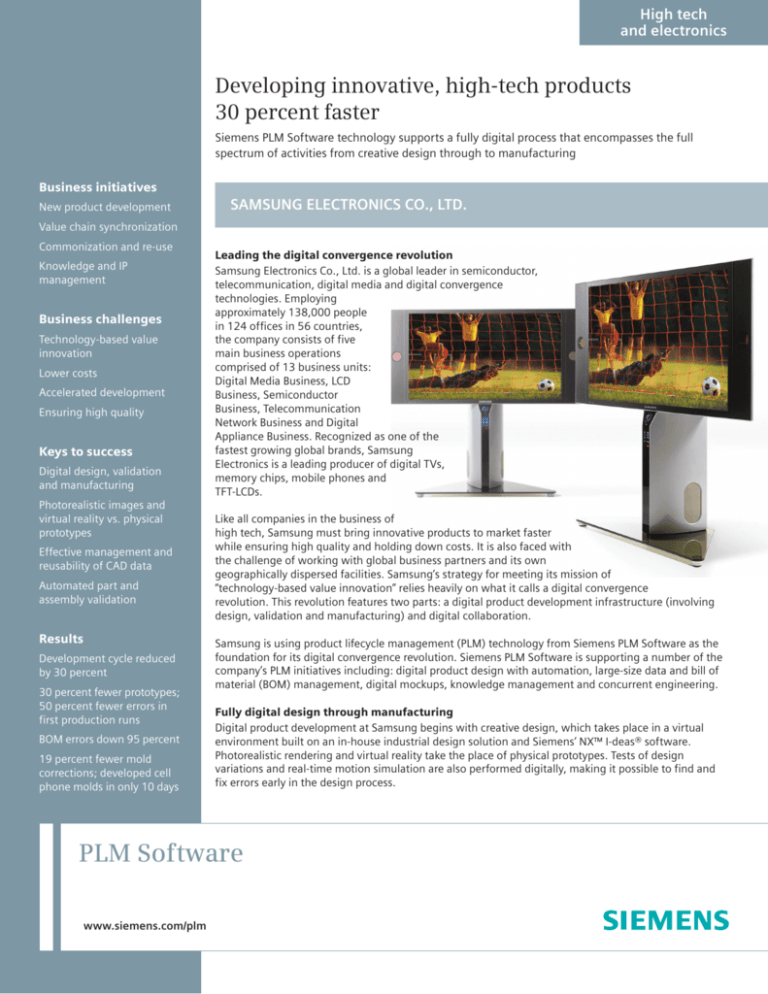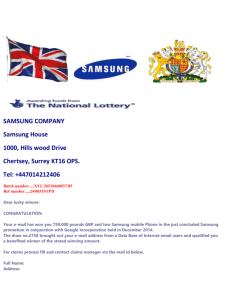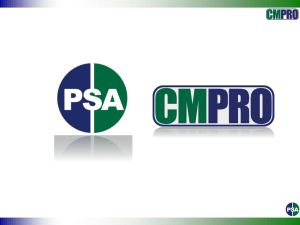
High tech
and electronics
Developing innovative, high-tech products
30 percent faster
Siemens PLM Software technology supports a fully digital process that encompasses the full
spectrum of activities from creative design through to manufacturing
Business initiatives
New product development
Samsung Electronics Co., Ltd.
Value chain synchronization
Commonization and re-use
Knowledge and IP
management
Business challenges
Technology-based value
innovation
Lower costs
Accelerated development
Ensuring high quality
Keys to success
Digital design, validation
and manufacturing
Photorealistic images and
virtual reality vs. physical
prototypes
Effective management and
reusability of CAD data
Automated part and
assembly validation
Results
Development cycle reduced
by 30 percent
30 percent fewer prototypes;
50 percent fewer errors in
first production runs
BOM errors down 95 percent
19 percent fewer mold
corrections; developed cell
phone molds in only 10 days
Leading the digital convergence revolution
Samsung Electronics Co., Ltd. is a global leader in semiconductor,
telecommunication, digital media and digital convergence
technologies. Employing
approximately 138,000 people
in 124 offices in 56 countries,
the company consists of five
main business operations
comprised of 13 business units:
Digital Media Business, LCD
Business, Semiconductor
Business, Telecommunication
Network Business and Digital
Appliance Business. Recognized as one of the
fastest growing global brands, Samsung
Electronics is a leading producer of digital TVs,
memory chips, mobile phones and
TFT-LCDs.
Like all companies in the business of
high tech, Samsung must bring innovative products to market faster
while ensuring high quality and holding down costs. It is also faced with
the challenge of working with global business partners and its own
geographically dispersed facilities. Samsung’s strategy for meeting its mission of
“technology-based value innovation” relies heavily on what it calls a digital convergence
revolution. This revolution features two parts: a digital product development infrastructure (involving
design, validation and manufacturing) and digital collaboration.
Samsung is using product lifecycle management (PLM) technology from Siemens PLM Software as the
foundation for its digital convergence revolution. Siemens PLM Software is supporting a number of the
company’s PLM initiatives including: digital product design with automation, large-size data and bill of
material (BOM) management, digital mockups, knowledge management and concurrent engineering.
Fully digital design through manufacturing
Digital product development at Samsung begins with creative design, which takes place in a virtual
environment built on an in-house industrial design solution and Siemens’ NX™ I-deas® software.
Photorealistic rendering and virtual reality take the place of physical prototypes. Tests of design
variations and real-time motion simulation are also performed digitally, making it possible to find and
fix errors early in the design process.
PLM Software
www.siemens.com/plm
High tech
and electronics
Solutions/Services
NX
www.siemens.com/nx
Teamcenter
www.siemens.com/teamcenter
Client’s primary
business
Samsung Electronics Co.,
Ltd. is a global leader in
semiconductor,
telecommunication, digital
media and digital
convergence technologies.
www.samsung.com
Client location
Suwon
Korea
Special recognition
Grand Prize Winner of AP
PLM Innovation Award 2007
“PLM technology from
Siemens PLM Software
supports Samsung’s
PLM initiatives for
digital product design
with automation,
data and bill of
material (BOM)
management, digital
mockups, knowledge
management and
concurrent
engineering.”
Mechanical designers follow a configuration-based
design process. Top-down design based on standard
structures and specifications is employed. A mechanical
library management system based on Siemens’
Teamcenter® software enables designers to find and reuse existing parts. Samsung has a fully automated part
and assembly validation system based on Teamcenter.
The system performs more than 500 validation jobs
every day in real time.
Samsung has automated much of the mold design and
manufacturing process. The automated system, which
was developed in-house, is based on rules and
continuously updated corporate knowledge. It helps
avoid human error and allows the company to develop
molds for a cellular phone in the amazingly short span
of just 10 days.
Samsung’s process for product data management and
BOM management was developed by Samsung Data
Systems and Siemens PLM Software engineers using Teamcenter to effectively
manage the flow of product data and to automatically generate bills of material,
which are synchronized with the CAD product structure.
Benefits across the board
One of the advantages of this fully digital design-through-manufacturing
approach is greater efficiency in product design. The ability to find and re-use
previously validated CAD data has helped shrink the development cycle by 30
percent. In addition, Samsung’s process for evaluating design is now more
effective. Using digital renderings and mockups has reduced the need for
physical prototypes by 30 percent. Automated BOM generation has reduced
errors by 95 percent.
In the manufacturing realm, automation has also reduced errors, as evidenced by a
19-percent decline in corrections needed to molds and a 50-percent reduction in
errors found in first production runs. Collaboration has improved as well, with work-in-process and
release data shared globally in one integrated system, and CAD-BOM consistency maintained during
engineering changes.
Samsung is now preparing to migrate from NX I-deas to the NX product development solution. It also
plans to expand its use of Teamcenter overseas, and ultimately to have a concurrent engineering
environment that includes all overseas facilities.
Sehyun Kim
Vice President
R&D Innovation Team
Samsung Electronics
Co., Ltd.
Contact
Siemens PLM Software
Americas
800 498 5351
Europe
44 (0) 1276 702000
Asia-Pacific 852 2230 3333
www.siemens.com/plm
© 2010 Siemens Product Lifecycle Management Software Inc. All rights reserved. Siemens and the Siemens logo are registered trademarks of Siemens AG.
D-Cubed, Femap, Geolus, GO PLM, I-deas, Insight, Jack, JT, NX, Parasolid, Solid Edge, Teamcenter, Tecnomatix and Velocity Series are trademarks or registered
trademarks of Siemens Product Lifecycle Management Software Inc. or its subsidiaries in the United States and in other countries. All other logos, trademarks,
registered trademarks or service marks used herein are the property of their respective holders. X3 11011 6/10 B








